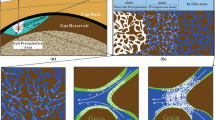Abstract
By measuring the variation of the P- and S-wave velocities of tight sandstone samples under water saturation, it was confirmed that with the decrease in water saturation, the P-wave velocity first decreased and then increased. The variation in velocity was influenced by the sandstone’s porosity. The commonly used Gassmann equation based on fluid substitution theory was studied. Comparing the calculated results with the measured data, it was found that the Gassmann equation agreed well with the measured data at high water saturation, but it could not explain the bending phenomenon of P-wave velocity at low saturation. This indicated that these equations could not accurately describe the relationship between fluid content and rock acoustic velocity. The reasons for this phenomenon were discussed through Taylor’s expansion. The coefficients of the fitting formula were calculated and verified by fitting the measured acoustic velocity changes of the cores. The relationship between P-wave velocity and saturation was discussed, which provides experimental support for calculating saturation using seismic and acoustic logging data.
Similar content being viewed by others
References
Brie, A., Pampuri, F., Marsala, A.F., et al., 1995, Shear sonic interpretation in, gas-bearing sands.
Cheng, C., Zhang, S.D., and Pan M., 2007, The acoustical characteristic research based on the physical property change of the sandstone: Natural Gas Industry (in Chinese), 27(9):40–43+130-131.
Deng, S.G., Niu, Y.F., and Zhao, Y., et al., 2016, Nuclear magnetic resonance-acoustic velocity joint experiment of tight gas sandstone: ACTA PETROLEI SINICA (in Chinese), 37(6):768–776.
Domenico, S., 1976, EFFECT OF BRINE-GAS MIXTURE ON VELOCITY IN AN UNCONSOLIDATED SAND RESERVOIR: Geophysics, 41(5):882–94.
Fang, C.H., Pan, B.Z., and Liu, S.H, et al., 2015, Experimental study and application on effect of gas saturation on P-wave velocity: Progress in Geophysics (in Chinese), 30(04):1673–1676.
He, X.L., Lin, K., and Zhang, Z.H., et al., 2018, Quantitative comparison of the influence of porosity and pore structure on reservoir characteristics: Geophysical prospecting for petroleum (in Chinese), 57(2):179–185.
Jia, L.Y., Li, L. and Wang, Q.Y., et al., 2018, Research on calculation methods of fluid bulk modulus, Progress in Geophysics (in Chinese), 33(1):0223–0227.
Kahraman, S., 2007, The correlations between the saturated and dry P-wave velocity of rocks: Ultrasonics, 46(4):341–348.
Kozlowski, M., Quirein, J., and Engelman, B., et al., 2017, Quantitative interpretation of sonic compressional and shear logs for gas saturation in medium porosity sandstone: SPWLA 58th Annual Logging Symposium, 17–21 June, SPWLA-2017-RRR.
Li, D.Q., Wei, J.X., and Di, R.B., et al., 2017, Corrections between the saturated and dry P-wave velocity of argillaceous sandstone: Progress in Geophysics (in Chinese), 32(4):1574–1583.
Lin, K., 2010, Based on Gassmann equation elastic parameters numerical simulation: Chengdu University of Technology(in Chinese).
Lin, K., He, Z.H., and Xiong, X.J., et al., 2009, Based on Gassmann equation Flow substitution flow: Journal of Yangtze University (in Chinese), 6(01):180–181+205+391.
Li, X., Shi, Y.J., and Wang, L., et al., 2013, Logging identification and evaluation technique of tight sandstone gas reservoirs: Taking Sulige gas field as an example: Natural Gas Geoscience (in Chinese), 24(1):62–68.
Li, W.X., Shi, G., and Wang, H., et al., 2007, The Study on the relationships of elastic properties of rock physics: Progress in Geophysics (in Chinese), 22(5):1380–1385.
Si, W.P., Di, B.R., and Wei, J.X., 2015, Seismic response variation of tight gas sand for uniform and patchy saturation patterns: Journal of Applied Geophysics, 116(5):167–172.
Si, W.P, Di, B.R, and Wei, J.X., et al., 2016, Experimental study of water saturation effect on acoustic velocity of sandstones: Journal of Natural Gas Science and Engineering, 33(7):37–43.
Si, W.P., Di, R.B., and Wei, J.X., 2017, Seismic physical modeling and gas saturation prediction of partially-saturated gas sand reservoir: Chinese Journal of Geophysics (in Chinese), 60(4):1547–1556
Shi, G., Shen, W.L., and Yang, D.Q., 2003, The relationship of wave velocities with saturation and fluid distribution in pore space: Chinese Journal of Geophysics (in Chinese), 46(01):138–142.
Tan, T.D., 1990, An interpretation technique for visually identifying gas formation by means of velocity ratio of compressional and shear waves: ACTA PETROLEI SINICA(in Chinese), 11(3): 41–49.
Wang, C.Z., and Zhang, L.J., 2007, Model of gas saturation determination based on elastic modulus: Petroleum Exploration and Development (in Chinese), 34(05):598–602.
Wang, L., Wang, X.Q., and Wu, S., et al., 2011, Method of gas saturation prediction by elastic modulus: Journal of Southwest Petroleum University (in Chinese), 33(04):69–72+190-191.
Zhu, H.L., Liu, X.J., and Liu, H., 2011, Experimental research on effect of gas saturation on acoustic wave velocity of carbonate rock: Chinese journal of Rock Mechanics and Engineering (in Chinese), 30(S1):2784–2789.
Author information
Authors and Affiliations
Corresponding author
Additional information
This work was supported by NSFC(42072323 and 42204122).
Pan Bao-Zhi has been a professor at the College of Geoexploration Science and Technology, Jilin University, since 2020. Her main work is focused on the research of sound waves in petrophysics. E-mail: panbaozhi@jlu.edu.cn.
Rights and permissions
About this article
Cite this article
Bao-Zhi, P., Wei-Yi, Z., Yu-Hang, G. et al. Effect of gas saturation on P-wave velocity in tight sandstone. Appl. Geophys. (2023). https://doi.org/10.1007/s11770-023-1005-3
Received:
Revised:
Published:
DOI: https://doi.org/10.1007/s11770-023-1005-3



